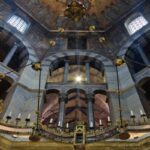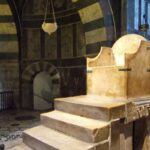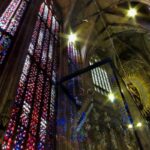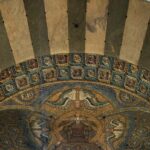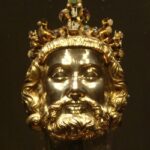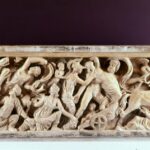Station Religion
Aachener Dom
Charlemagne’s original St. Mary’s Church survives to this day as the core structure of the Aachen Cathedral. It was the sacral centre of the Carolingian empire and became the coronation church of medieval kings. As stations on the Route Charlemagne, the Cathedral along with the Cathedral Treasury and the planned Cathedral Information document the history of Aachen and deal with the theme “Religion”.
Charlemagne’s palace, the era of coronations and the tradition of pilgrimages have produced an unique and magnificent church treasure whose most famous pieces are on show today in the Cathedral Treasury.
Cathedral: Charlemagne's sacral centre of his empire
Charlemagne’s idea was to create a sacral centre of his empire in Aachen. But this was not just to put his own personal faith on record. On the contrary, the introduction of a common Christian religion with a standardised liturgy was also one of his political power bases. St. Mary’s Church, today’s Cathedral, was intended as an expression of this power. It was built over the past years of the 8th century and combined Byzantine and Antique architectural styles. The impact of the new church on contemporaries was enormous. This was the first time since the days of antiquity that a domed structure of this size had been successfully accomplished north of the Alps.
In 814, Charlemagne was laid to rest here
The centuries that followed saw an increasing sacralisation of the emperor which reached its climax in the legendary opening of his tomb in 1000 and in his canonisation in 1165. Since 1215 Charlemagne’s mortal remains have rested in a golden shrine now situated in the centre of the cancel. The golden alterpiece (ca. 1000), the pulpit (pre-1014) and the chandelier donated by Friedrich Barbarossa (ca.1165) all date from this era.
On this throne, from 936 onwards, the German kings were crowned
The central element of St. Mary’s Church is an octagon surrounded by a sixteen-sided walkway. On a gallery stands a marble throne, presumed to have symbolised the Lordship of Christ. It was on this throne that, from 936 onwards, the German kings were crowned. The Carolingian core structure of the church survives to this day. The mighty westwork with its entrance hall and massive bronze portal also dates back to the times of Charlemagne.
Tradition has it that Charlemagne brought some of the most precious relics in all Christendom to Aachen
Their rediscovery in the 14th century inspired a tradition of pilgrimage that elevated Aachen to the same rank as Rome and Santiago de Compostela as a European destination for pilgrims. The relics are kept in another shrine in the cancel. Worship of the relics through pilgrimage began in 1349 and continues to this day. Like the coronations, the pilgrimages were an important economic and cultural factor for the medieval town.
To cater for the huge celebrations of coronations and pilgrimages, a new cancel was inaugurated in 1414, on the 600th anniversary of Charlemagne’s death. After the octagon, this is the Cathedral’s second architectural masterpiece, for the greater part of its exterior façade consists of glass. The enormous weight of the vaulting seems to rest on slender pillars without any further means of support. In reality, the weight is borne by a complicated anchoring system.
In 1978, it became the first German monument to be declared by UNESCO as a World Cultural Heritage site
In addition, since the 13th century a ring of lateral chapels has formed around the church. A cloister connects the church to the Cathedral monastery and today’s Cathedral Treasury. The Cathedral was first elevated to the status of a bishop’s seat for a while during Napoleonic times and then permanently in 1930. A planned visitors’ centre will provide information on the Cathedral.
In the framework of the Route Charlemagne, the Cathedral, the Cathedral Treasury and the Cathedral Information will represent the theme “Religion”. They will complement the exhibitions on the city’s history in the Town Hall and in the future Centre Charlemagne.




